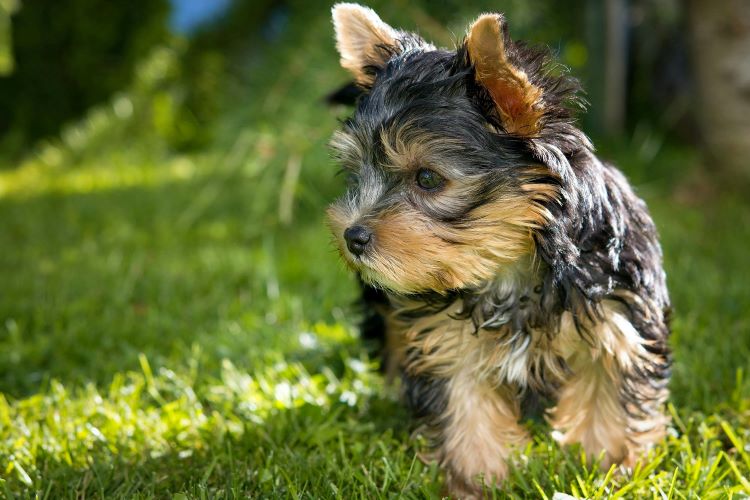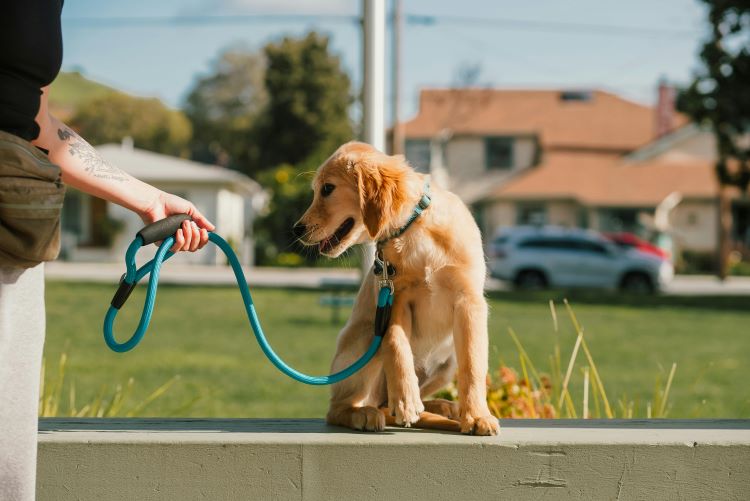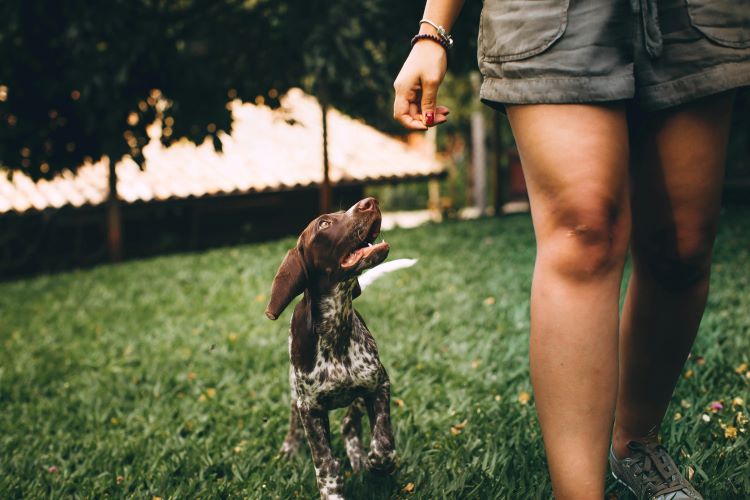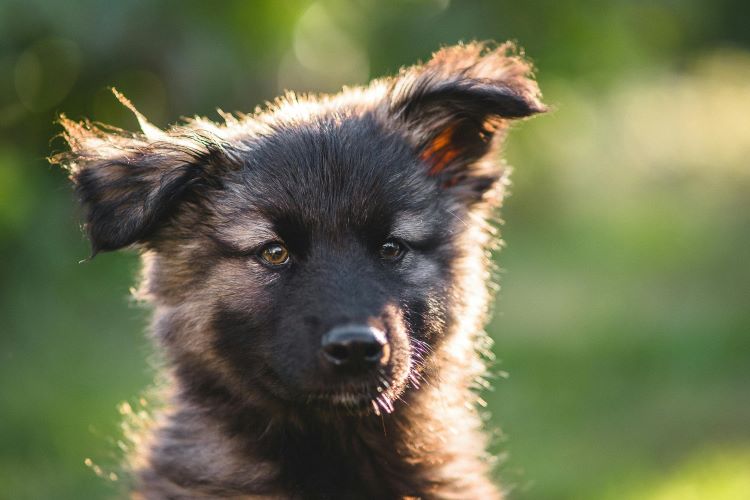Ready to help treat your pet to a healthy life?
How to Potty Train a Puppy in 6 Steps (Plus Extra Tips!)
By : Trupanion Staff | Published Jan 23, 2025

Just like human children, puppies aren't born knowing appropriate bathroom habits. Unless you want to deal with a mess in your home multiple times a day (and risk creating a biohazard wherever you take your pet), you’ll need to take some time to teach your new puppy to go outside. In fact, some consider this to be one of the most important forms of basic puppy training.
If you’ve never potty trained a dog before or it’s just been a while, it’s normal to feel a bit intimidated by the task. Accidents and mistakes are common during all kinds of early puppy training, but following the advice in this article can help things go more smoothly.
We’ll get into the details in just a moment, but the important things to remember are that a predictable schedule, consistent rules, and plenty of supervision will help reduce the risk of indoor accidents along the way. Ready to become a puppy potty training pro? Let’s go!
How long does it take to potty train a puppy?
Many new dog owners want to know how to potty train a puppy as fast as possible. The truth is that the time it takes varies between individual dogs. Most puppies learn to use their toilet spot outside within a few months, although some may learn more quickly (while others take longer).
The consistency of your training will also make a difference. Your puppy will likely learn much faster if you dedicate time to potty training and follow the same consistent steps every time you go outside.
Bear in mind that puppies don't achieve full bladder capacity until they're around a year old. So, you may experience the occasional floor puddle until your pup's old enough to hold their urine longer.
What about older dogs?
This probably doesn’t come as any surprise, but puppies tend to learn to use the toilet outside faster than older dogs. The potty training process is the same for older dogs and puppies, and contrary to popular belief, it is possible to teach adult canines proper bathroom habits. That said, adult dogs may need more time and patience before mastering the skill.

6 Puppy potty training steps
Potty training a puppy requires empathy and patience. However many pet owners find it to be a rewarding experience. Done right, the potty training process can help build trust and strengthen the bond between you and your pet.
1. Start bringing them outside
The only way to get your pup to start going to the toilet outside is, you guessed it, bringing them outside when they need to go! As mentioned earlier, puppies can't hold their urine for extended periods. You can increase your chances of success by being proactive. Planning regular trips reduces the risk of accidents and gives your pup plenty of opportunities to practice this new skill. Take your puppy outside to go to the toilet every 45 minutes and at the following times:
- First thing in the morning
- Last thing before bed
- After meals
- After play sessions
- Before leaving the house and after coming home
Consistency is critical to successful training. If you're sharing the job with other family members, ensure they know how to potty train a puppy and follow the same process to avoid confusing your pet.
Many owners find it helpful to take some time off work or requesting to work from home (if possible) while potty training a puppy.
2. Learn the signs your puppy needs to go outside
Obviously, the goal is to get your pet outside before an accident happens. Signs of needing to go can vary between puppies, and observing your puppy's body language can help you learn their particular signals. Common signs include:
- Appearing restless or uncomfortable
- Sniffing the floor
- Circling
- Revisiting spots where they’ve peed or pooped before
- Barking (once potty training begins, they may start barking at the door)
- Scratching at doors or areas where they’ve gone before
- Squatting
3. Choose a doggy bathroom spot
Teaching your puppy to use in the same spot in your yard can make it easier to keep your yard poop-free. It can also help ease your pup into the routine. Take your pup to the designated place during every toilet trip.
Want to go the extra mile? Some pet owners suggest choosing a command to say while your pet goes potty outside. Over time, your pup will learn to associate that word with doing their business, allowing you to prompt them to go when needed (i.e., when you need to take them outside before leaving for a few hours).
4. Supervise your pup
Supervising your pup during potty training is essential, or you risk missing key signals. For one thing, you’ll want to ensure they actually go to the bathroom when outside and that they’re all finished before you head back in.
It's wise to stay with your puppy as much as possible whenever they’re outdoors. Having your pup on a long leash during downtime makes it easier to keep her with you and act when they need to go to the bathroom without restricting them. Keep them leashed in the yard until they reliably visit their designated area.
5. Praise and reward
In the initial stages, praise your puppy or offer them a treat as soon as they finish going potty outside. It's essential to reward them immediately to reinforce good bathroom behavior. Watch your pup carefully to ensure they’re finished before receiving praise and treats. Otherwise, they may stop going too soon, increasing the risk of accidents indoors.
6. Stick to regular meal and bed times
Potty training should be part of establishing an overall daily routine for your young dog. They should be given meals consistently at the same time every day, and you should also encourage them to sleep at night at the same time. Work in bathroom breaks around this schedule where they make sense, such as shortly after mealtimes and then right before bedtime. Knowing when your pup will likely need a toilet trip will also help make puppy potty training easier to manage.

Preventing puppy potty training problems
The path to a potty-trained pup isn't always smooth. Knowing how to troubleshoot common problems can help you deal with setbacks and get your training routine back on track.
Managing trips away from home
If you can't always supervise your puppy, you'll need to plan for your puppy's toileting needs while you're out. Crate training your puppy can help you manage short, unsupervised periods because pups don't usually go to the toilet where they sleep. Take your puppy to her outdoor potty area as soon as you get home.
Hiring a pet sitter with experience potty training pups or asking a friend or family member to help is the best way to manage longer trips. Ensure the person caring for your pup uses your usual potty training methods to maintain consistency.
Alternatively, you can train your puppy to toilet in a designated indoor area by providing puppy potty pads or protecting the area with newspaper. However, allowing your pup to pee and/or poop inside can make outdoor potty training more challenging, and your dog may soon develop a tendency of going indoors.
Deal with accidents appropriately
Most puppies have accidents inside the house at some point during their potty training journey. Frequent mistakes can create the habit of toileting indoors, and you can minimize accidents by taking your puppy to their outdoor spot often. However, the occasional indoor puddle is normal and, as long as you react quickly and appropriately, won't harm your potty training efforts.
If your puppy pees or poops indoors, take them straight out to her toileting area and praise her if she finishes eliminating in the designated spot. Punishing or scolding your pup for accidents can make her fearful and create anxiety around toileting, so it's best to avoid dramatic reactions to puppy mistakes.
Remember: the keys here are consistency and reacting appropriately. Continuing to allow your puppy to pee or poop inside the house will undermine your training efforts and promote bad habits.
Clean up pet messes to prevent future accidents
Puppies and adult dogs tend to toilet in places that smell of their own urine and feces, so cleaning up puppy potty training accidents is essential. Regular household cleaners don't eliminate the scent. Instead, use an enzymatic cleaning fluid designed to remove the smell of pet urine and poop.
Ideally, you should clean accidents as soon as you notice them by blotting the area dry with paper towels and applying the enzymatic cleaner according to the manufacturer's instructions. If you didn't notice the accident right away, dampen any dried areas with warm water before blotting.

When to seek veterinary attention
Most puppies learn to do their business outside without issue, but frequent accidents can sometimes signify an underlying health concern. Consult your vet if your puppy doesn't make progress during potty training. Your vet can check your pup for health issues and provide additional house-training advice. You should also schedule a vet visit if your house-trained puppy or older dog suddenly starts peeing and pooping indoors again.
Unneutered male puppies and dogs often pee inside the house to scent-mark their territory. In this situation, you could consider neutering your pet to help resolve marking behavior.
Puppy training supports your pet in learning healthy habits for adulthood, and insuring your new family member can help you prepare for unexpected health care costs. Puppyhood is the ideal time to sign up for dog insurance because insuring your pet when they’re young can help you get the best value from your policy.
